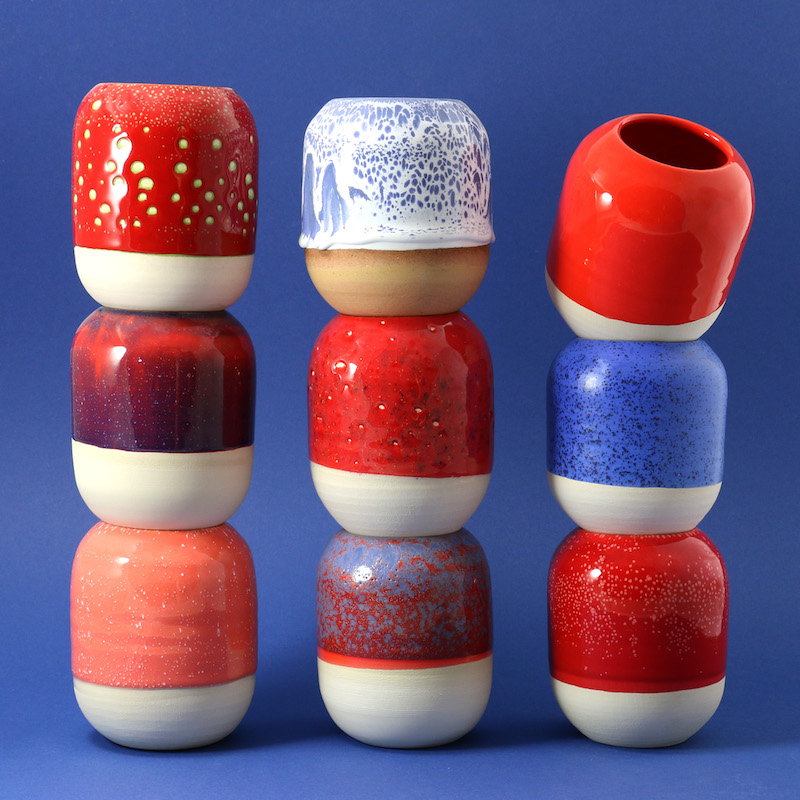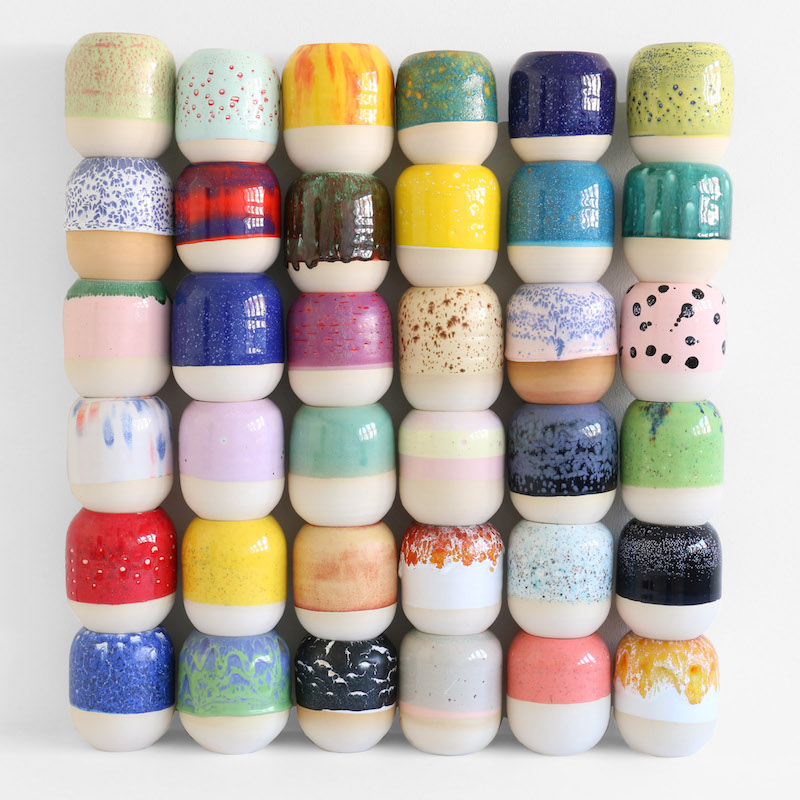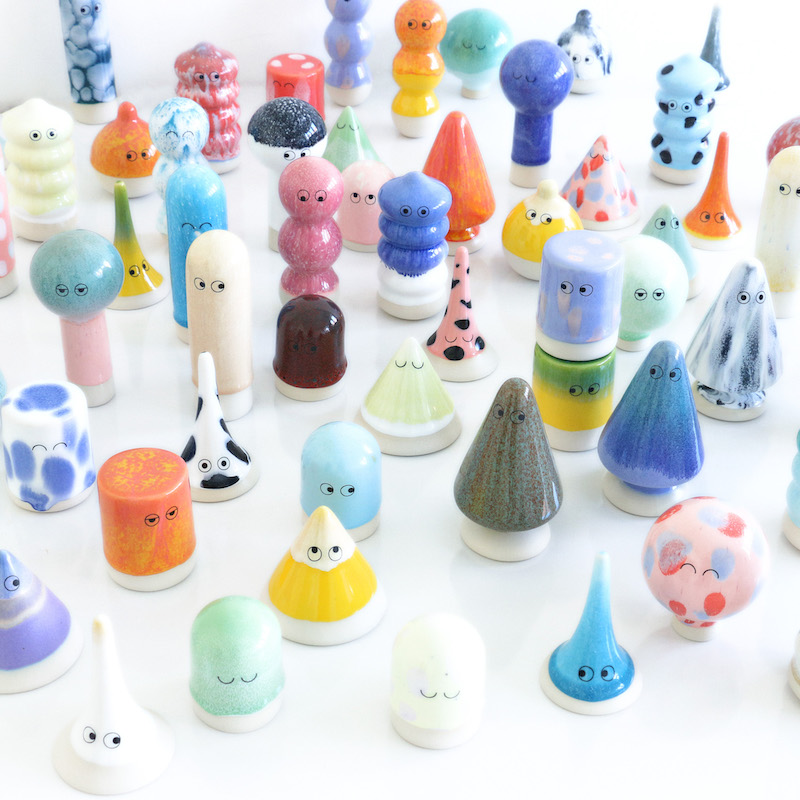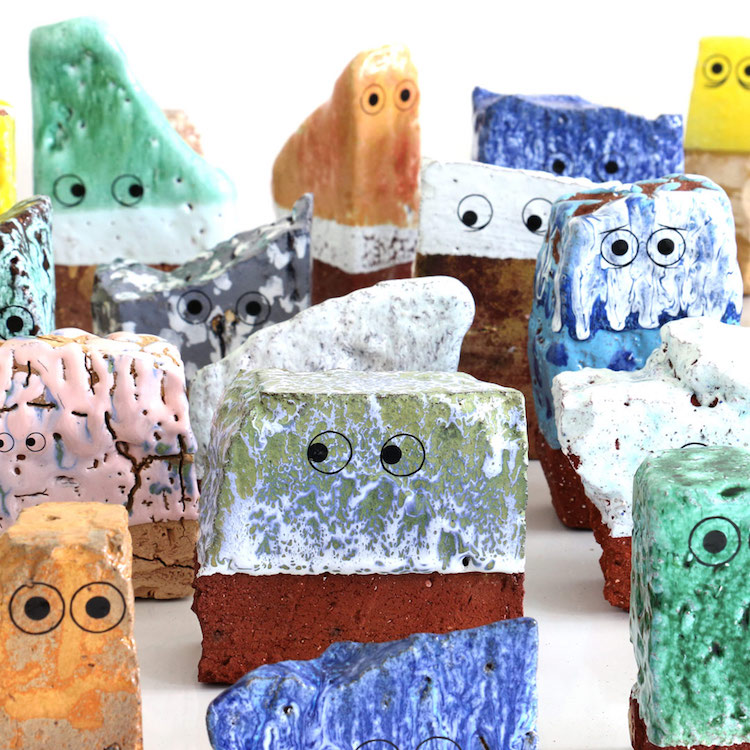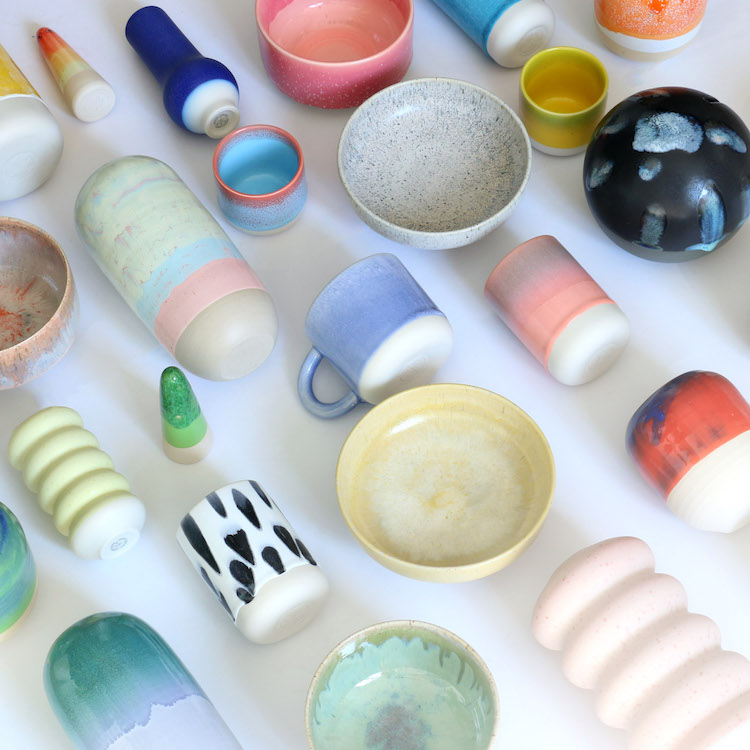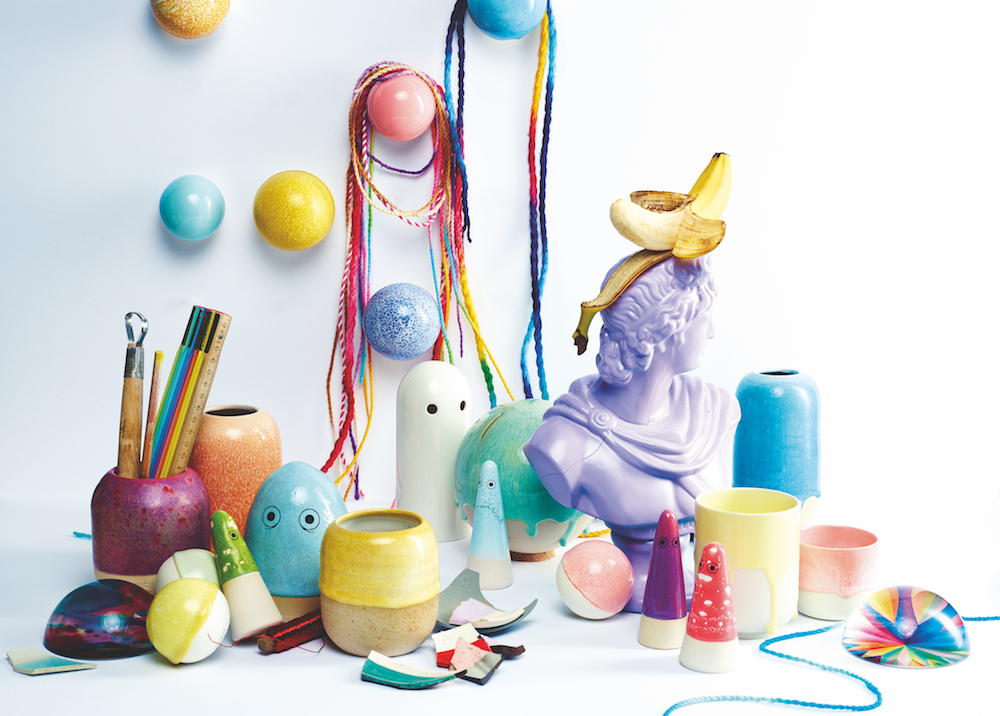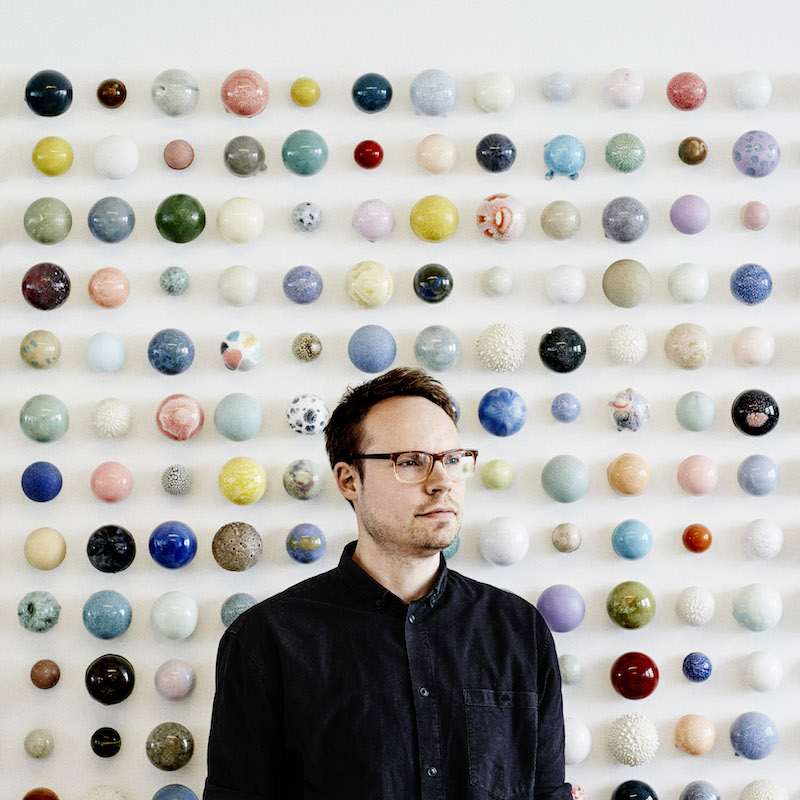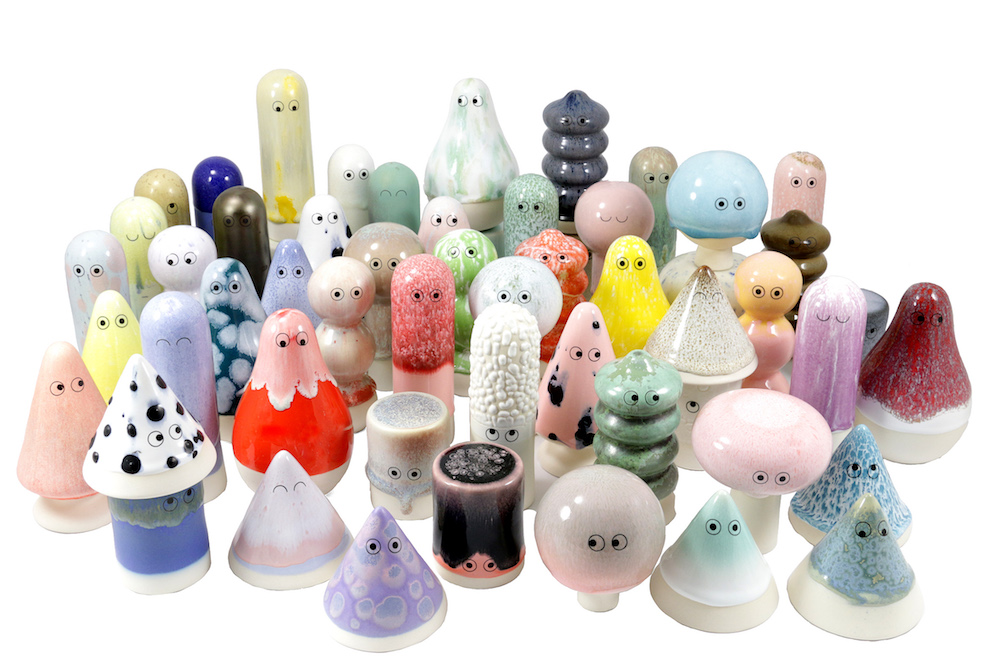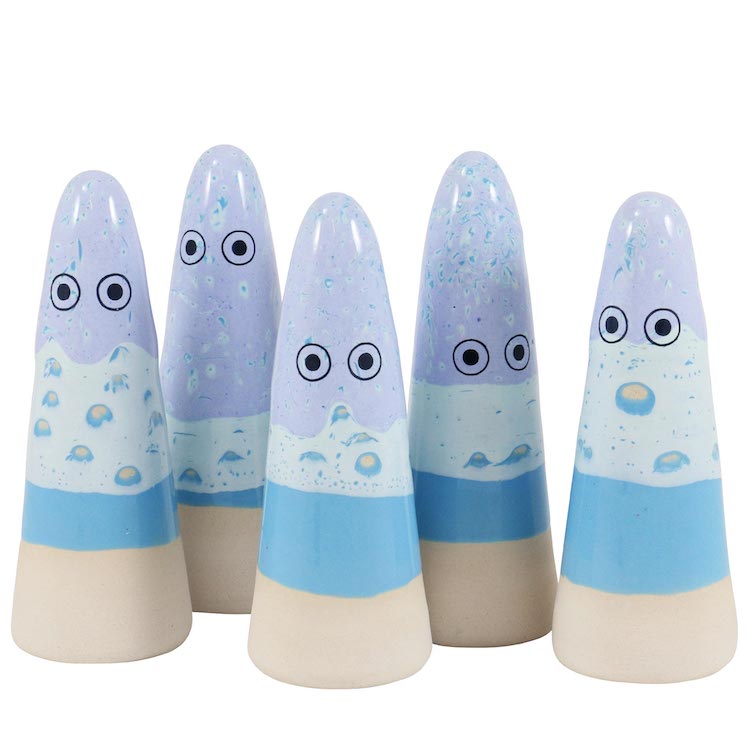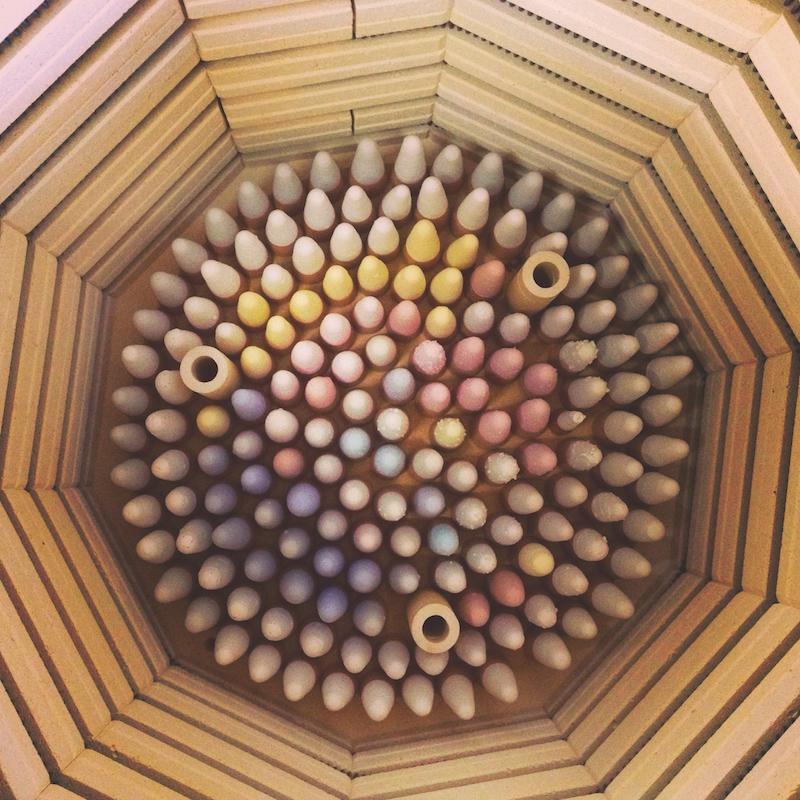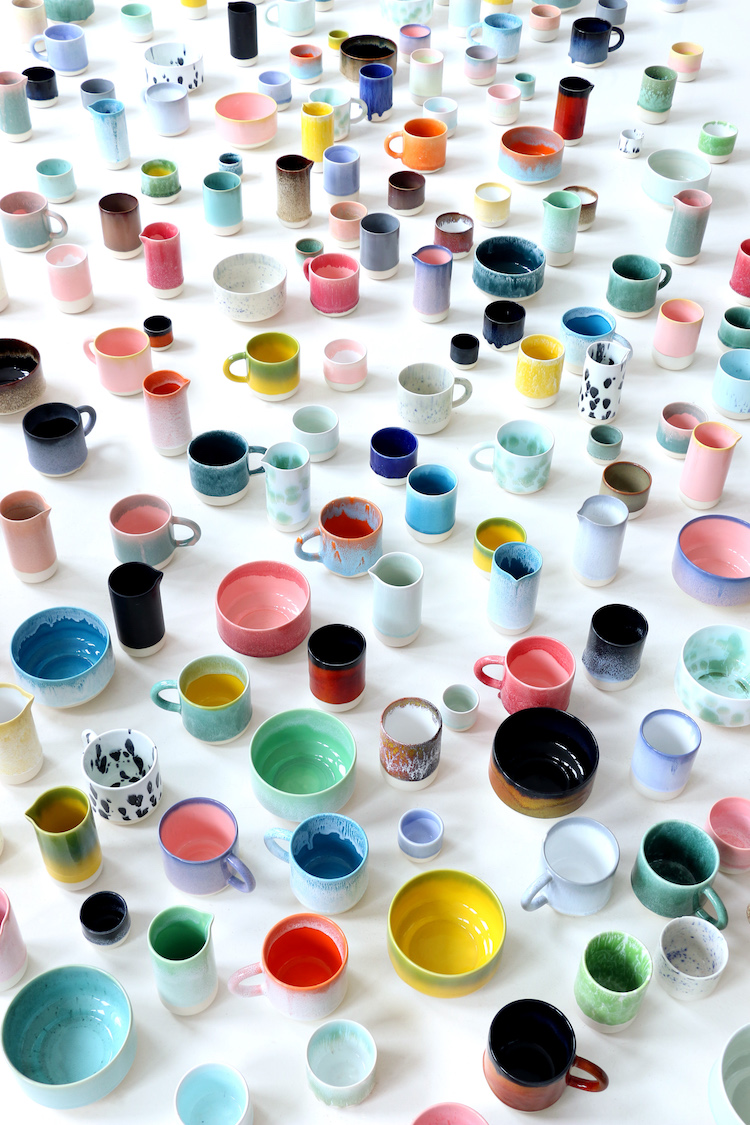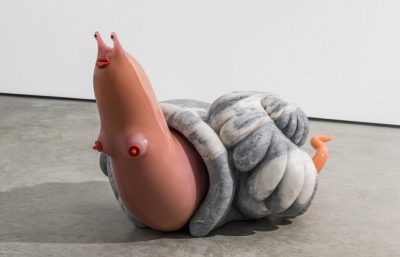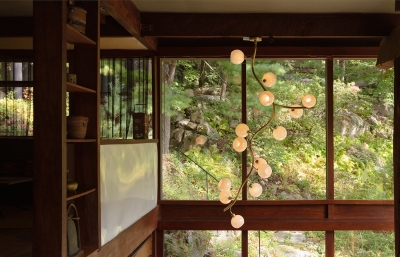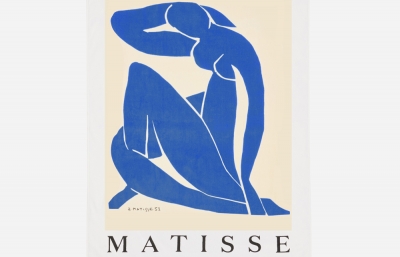The ghosts of Studio Arhoj grabbed me. Haunting a table at Denmark’s Louisiana Museum, they conjured a youthful delight so powerful, I immediately adopted one, and then another; my ghost needed a pal. And so began a collecting obsession with the work of Anders Arhoj, an artist producing expressive ceramic sculpture alongside his tight-knit crew of potters who make artful snackware. From Chug Mugs to Brick buddies, absolutely everything Arhoj produces oozes joy. Studio Arhoj represents just one of Anders’s many talents as a designer, author and artist.
Kristin Farr: I like to imagine hosting a dinner party served exclusively on Arhoj objects, but I fear the aesthetics of my food could never live up to the beauty of your tableware. Do you get this comment a lot?
Anders Arhoj: No, never actually! In these Instagram days, many people, including chefs, really love to plate their food on something that plays along with it, instead of just being a white canvas. You can make some bold and dramatic dishes with magenta pink cherries on an Yves Klein-blue ceramic plate, or black ice cream in a shockingly sunbeam-yellow bowl. It’s about having fun and staging your dish to tell a story.
Tell me about the popular “mysterious mistakes gone good,” one-of-a-kind objects in your shop. There must be funny stories behind these creations.
Oh, yes, often. Most recently, last Christmas, I was home at my parents’ house in the Danish countryside and heard about a local clay digging site. There’s no public access, but I snuck in there, along with my dad, and dug out some fresh local clay. Back in the studio the week after, I made some sculptures in the clay and put them in the kiln. But instead of staying in shape, the high temperatures made them collapse completely into a flat pool on the kiln plate! If there had been more, it might have completely ruined the poor kiln. The clay was never meant to be fired so high. However, the melted pool was so beautiful—like a brown, rustic, glassy glaze full of earth particles and bits of minerals. We now use this local clay as a glaze for our products—and I need to trespass again soon to bring home even more of the good stuff, ha!
You should probably wear a disguise. I noticed you’ve been releasing more sculptural work, including pieces with that raw, textured finish. Does your crew seamlessly switch between art and functional objects?
Actually, I’m the sole sculptor in the studio. I make more or less all the pieces myself, as I really love to work with the clay in that way. Wheel throwing is not my primary interest of expression; I leave that to my potters. I prefer building, cutting and manipulating the clay itself. However, sculpture is definitely becoming a thing, even though our studio is not super interested in trends. I think people are buying less junk these days, and so instead of spending $100 on 10 crap items from distant parts of the world, you buy one beautiful piece from a local artist—it’s sustainable and much more of a personal object to have in your home instead of a mass-produced item.
Tell me about the series and how they develop, like the Ghosts, Bricks and Mountain Mine series. RELIC also seems to have a mysterious origin story…
I have always loved sculptures, local folk art, brown ceramic money banks from the 1970s—my home is full of that stuff, so I think it’s just a natural extension of creating characters and moving in the physical, three-dimensional direction. I have worked as a character designer for 18 years now, doing children’s TV websites, animation, visual identities, children’s books and more, so creating creatures in clay is just another medium for my work.
Regarding RELIC, our A/W 2018 collection, I was inspired by the Danish museums I grew up visiting. My parents took me to all these buildings around Denmark that were designed in the 1960s and housed ancient viking masks, swords and ships—old objects but exhibited in very modern, boxy surroundings, with exhibit glass displays dressed in fabric with different panels and small notes about the item and year. Something that was cool then, but today looks sort of dated—which I love! So I kind of wanted to take that feeling of old and new and see what came out of that. I’m also interested in digging into my own Northern heritage and my ancestors’ dimension without it looking like an episode of Vikings on HBO.
What kinds of experiments or innovations have happened in your studio that you are most proud of?
I’m still proud of our Ghosts—the little cone in clay. We throw it on the wheel and it’s not hollow, but solid, which most ceramicists would never do, as clay usually explodes in the kiln when it’s not hollowed out. But we found a way to make things with mass, and breaking that “rule” was just very pleasing to me. I also love using materials that aren’t really supposed to be used in that way, minerals or glazes that people usually don’t fire to a high temperature, but we do, and fun stuff comes out of that.
The Ghost will always remain a classic to me—it was the product that started the studio and which broke us through to the mainstream. It’s really a very simple object, yet surprisingly hard to perfect and produce. And many people collect and use the Ghosts as talismans, travel souvenirs, representations of family members, and more.
What is your studio like? Is it open for the public to visit?
I built the studio as a white box with all surfaces reflecting light, which allows us to clearly observe colors precisely and correctly.
Our Studio Design Store featuring all our designs and some exclusive in-store only items is open to the public. Everyone can walk in and observe us work through the open shelves and tables while they shop. The rest of the studio is not open to the public—we have many research projects, secret new products, and upcoming news laying around, so we can’t have strangers walk around in there. Ha!
What kinds of music are best for optimal Arhoj production?
If I could decide, we would listen all day to 1990’s electronica from Warp Records, classical minimalism by Steve Reich, or John Adams, or sappy 1970’s Carpenters LPs. Unfortunately, the rest of the team do not agree with that, so it’s mostly a battle of the sound system. We actually create and release our own curated playlists on Spotify, and everyone can check them out! Search for Studio Arhoj. I do prefer my own tunes, which is why I’m working on building my own tiny studio-in-studio where I can close the door, sculpt and listen to odd music in peace.
Why are you drawn to making objects with simple but expressive faces?
I think it’s exactly like that actually; my characters are objects—with a personality.
Not the other way around, like a rock in the river that comes to life and looks up at you.
My products are closer to design than to children’s toys, which maybe explains why I personally like character design that is either hysterically sweet, border-lining insane, or very dark and cruel. I have no interest in middle-of-the-road cartoons featuring normal children or a nice dog. Perhaps because I’m Danish I’m attracted to simplicity; underplaying instead of overplaying, and without lots of ornate decor. If the representation of a face is very subtle, you can also add your own ideas about who and what this character is.
Why do you think ceramics are so successful for you? You work in many creative areas.
Because screens are boring and everything you make on them is quickly forgotten, deleted and defunct in a few years. I’ve been there—I spent 10 hours a day designing websites, banner ads, online brandings and Flash animations for many years, and it’s all gone here in 2019; all vanished into a digital river and it will, for sure, never come back. All those fun ideas, all that hard work—it’s like it never happened. A ceramic bowl will exist forever—at least longer than me or you. If you do good work, it’s a physical item that can be used for many years and give pleasure and function to people’s lives. Clay can do anything. There are no limits. And if there are, it’s a both creative and technical challenge to break those limits and show what can be done.
I also really love the juxtaposition of character design in clay, not plastic or metal. Clay can be super smooth, pink porcelain or rustic, dark and evil black stoneware with bubbling glazes and tactile surfaces. The material takes the design to new levels and also provides new problems, of course. You have to know what you’re doing in order not to destroy what you just made. But I always feel I know nothing. That I haven’t even started to grasp the possibilities of working in ceramics, and I’ve heard that’s basically what all ceramicists believe.
Besides the local Danish influence, you also take inspiration from Japan, where you studied, as seen in your substantial Tokyo series. Which parts of Japanese creative culture do you find most influential?
I moved to Tokyo in 2005 to study the Japanese language, and fell in love with the culture immediately. To me, what’s interesting about Japan is the intense meeting of old and new. Many traditions are still alive and well, and respected by the young generations—ancient arts and crafts, cultural education and awareness of their own Japanese history and heritage. But, at the same time, you see incredibly new and creative ideas borderlining the surreal and totally wacky. TV commercials with pink rabbits eating a new snack bar with squid, one hundred dancing bananas on a train—so much fun and weirdness that would never be produced in the West. I love that wackiness and I find a lot of inspiration in it, that it’s OK to remain fun and silly in our increasingly serious and politically correct society.
Are there any common obsessions or interests among your studio family recently?
Yes, we have been obsessing madly over our new studio dog, a Frenchie puppy called Hanx (named after the way Tom Hanks signs his tweets). She’s making our daily life much more fun and full of cuddly love.
We’re also excited that a new bike bridge opening up across the harbor in Copenhagen. The entire studio team bikes to work every day and it’s nice that our city keeps being a great place to ride a bike.
In the studio, we’re very focused on finishing up our upcoming Edo Series—the old name for Tokyo before 1868. As opposed to our white porcelain-based modern Tokyo Series, the Edo will be an interpretation of old Japan, featuring rough, course, pattern-carved stoneware and expressive, rustic glazes. Our new cups are based on the classic Yunomi shape but interpreted in our design language with decorate elements—each thrown piece is completely unique and quite intense. We are excited to hear what people think!
How do you hope people feel when they experience your work? They definitely increase my enjoyment of domestic activity.
That’s definitely one of the goals! To smile when your gaze lands on an item from our studio—that you enjoy your morning coffee just a little bit more when it’s in a bright yellow mug.
I also hope that people appreciate that the item was made with two hands by a real human and not in a machine, and that they want to invest in someone working hard to throw, sculpt, bisque fire, glaze and fire an item. It’s a long way from a lump of fresh clay to an actual breakfast bowl.
Find Anders’ ceramics at studioarhoj.com and at specialty stockists worldwide. San Francisco’s Chronicle Books released his latest children’s book title, CATCH ME, on March 1, 2019.
This article was originally publised in the Spring 2019 issue


